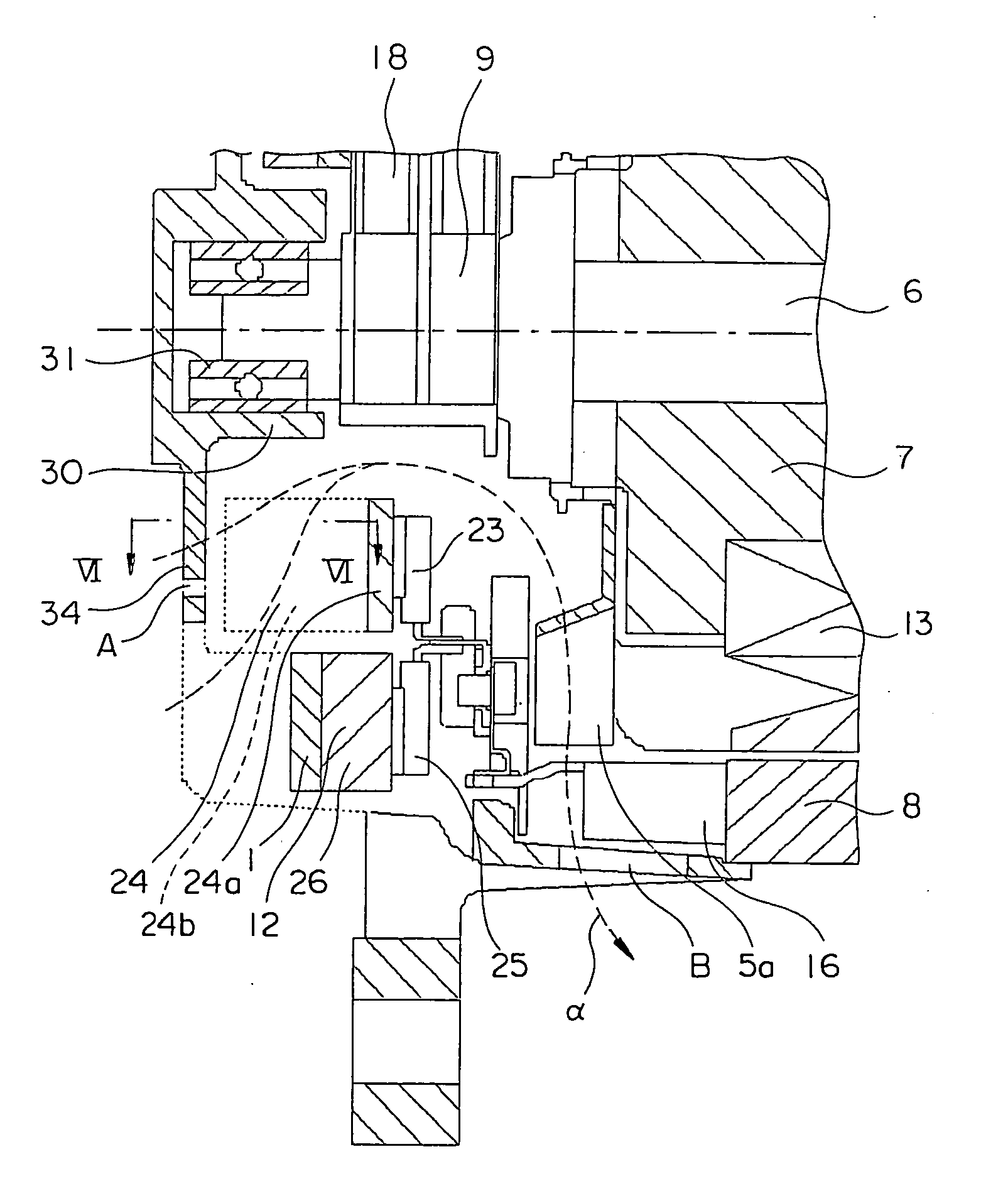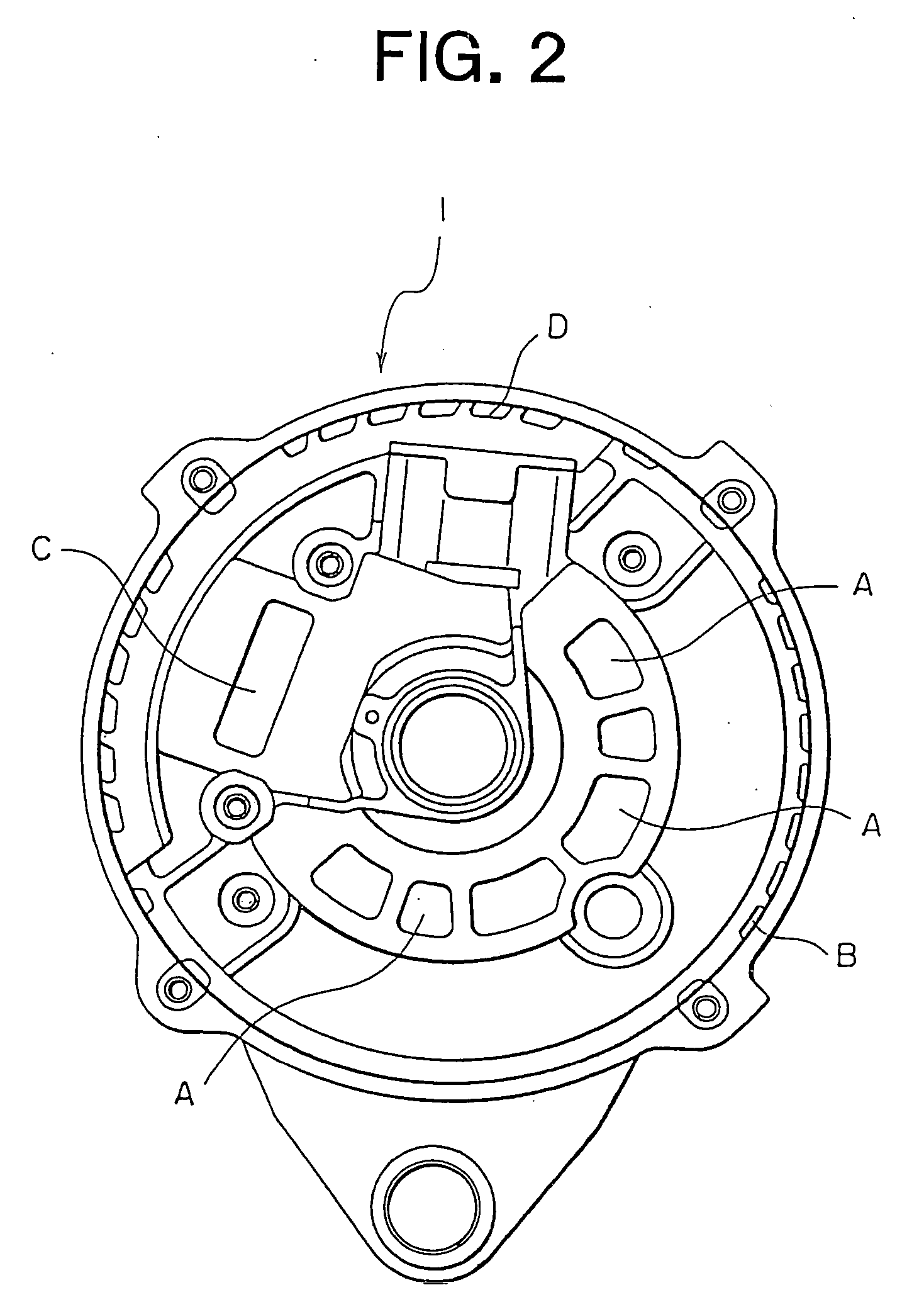Alternator
a technology of alternators and rotating parts, applied in the direction of magnetic circuit rotating parts, magnetic circuit shapes/forms/construction, windings, etc., can solve the problems of cost increase, temperature of rear bearing alone may exceed heat tolerance threshold, etc., and achieve the effect of suppressing temperature increases in rear bearings and increasing outpu
- Summary
- Abstract
- Description
- Claims
- Application Information
AI Technical Summary
Benefits of technology
Problems solved by technology
Method used
Image
Examples
embodiment 1
[0029]FIG. 1 is a cross section of an automotive alternator according to the present invention, FIG. 2 is a diagram showing a rear bracket 1 from FIG. 1 when viewed from inside, FIG. 3 is a diagram showing the automotive alternator from FIG. 1 when viewed from a rear bracket end, and FIG. 4 is an overall perspective showing a rectifier 12 from FIG. 1.
[0030] In this automotive alternator, a case 3 is constituted by a rear bracket 1 and a front bracket 2 made of aluminum. A rear bearing 31 is fitted into a rear bearing housing portion 30 of the rear bracket 1. A front bearing 33 is fitted into a front bearing housing portion 32 of the front bracket 2. The front bearing 33 and the rear bearing 31 rotatably support a shaft 6 having a pulley 4 fixed to a first end portion. A Lundell-type rotor 7 is fixed to an intermediate portion of the shaft 6. Slip rings 9 for supplying an electric current to the rotor 7 are fixed to a second end portion of the shaft 6.
[0031] A stator 8 is fixed to ...
embodiment 2
[0054]FIG. 8 is a partial cross section of an automotive alternator according to Embodiment 2 of the present invention.
[0055] This embodiment is similar to the automotive alternator according to Embodiment 1 except for the fact that each of the rear bearing cooling fins 34 is disposed between an adjacent pair of diode cooling fins 24b when the rear bracket 1 is viewed in an axial direction of the shaft 6.
[0056] In this embodiment, because external air turns inward at a downstream end of each of the rear bearing cooling fins 34 and is led between the diode cooling fins 24b, the cooling performance of the rear bearing cooling fins 34, in other words, the cooling performance of the rear bearing 31, is improved compared to that of Embodiment 1.
embodiment 3
[0057]FIG. 9 is a partial cross section of an automotive alternator according to Embodiment 3 of the present invention.
[0058] This embodiment is similar to the automotive alternator according to Embodiment 2 except for the fact that rear bearing cooling fins 34A are disposed so as to extend in an axial direction of the shaft 6 between adjacent pairs of diode cooling fins 24b.
[0059] In this embodiment, although the airflow led between the pairs of diode cooling fins 24b is significantly reduced, which lowers the cooling performance of the positive-side heat sink 24, the surface area of the rear bearing cooling fins 34A is increased and the cooling performance of the rear bearing 31 is improved significantly, enabling the temperature of the rear bearing 31 to be significantly reduced.
PUM
 Login to View More
Login to View More Abstract
Description
Claims
Application Information
 Login to View More
Login to View More - R&D
- Intellectual Property
- Life Sciences
- Materials
- Tech Scout
- Unparalleled Data Quality
- Higher Quality Content
- 60% Fewer Hallucinations
Browse by: Latest US Patents, China's latest patents, Technical Efficacy Thesaurus, Application Domain, Technology Topic, Popular Technical Reports.
© 2025 PatSnap. All rights reserved.Legal|Privacy policy|Modern Slavery Act Transparency Statement|Sitemap|About US| Contact US: help@patsnap.com



